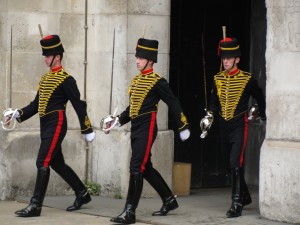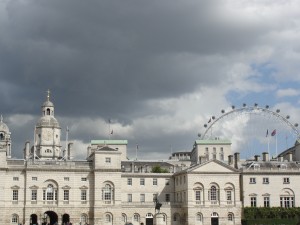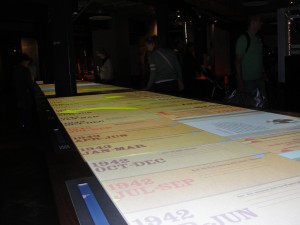Over the past year I found myself challenged with the question, “what is art?” I spent my entire time during my class, “The Politics of the Body: History & Improvisation” , last semester, arguing that very few of the performances we were observing were “art”*. However I have broadened my opinion on this subject matter and have recently opened my eyes to new definitions of “art”.
Last spring I categorized “art” into a few major categories: dance, music, theater, paintings, and sculptures. However as I began viewing more variations of art and have further discussed this huge question with my professors and my peers my definition of art has varied greatly. I would still consider the standard categories of art set, however looking into more performance art I find that definition to be much more shaky.
Thinking back at some of the things I have seen around London recently I began to think especially about performances and what is “art” in these terms. The first thing that I saw that I considered a performance was a changing of the guards that I saw near Parliament. The planned out speeches, the floor patterns, the intricate planning that comes with these ceremonies– it’s hard not to consider them a type of performance. There are also all sorts of styles, plans, and different organizations that plan out these ceremonies. A performance, yes. But is it art?
The following day I was in the same general area, over near Trafalagar Square, and someone pointed out the fourth ‘incomplete’ pillar. I had not noticed that there was always one person replacing one of the statues. The ‘performers’ do all sorts of varying things: dancing, singing, standing still dressed as Darth Vader, hitting small objects into the crowd, etc. Depending on what these people do can you consider them performers? And if we consider them performers are they artists? Is what they’re doing art?
So I still have no real definition of “art”. I still don’t know what I would consider “art”. But I’m working on it, and probably will continue to struggle with it for quite some time.


*I am choosing to refer to art in quotes, beause this entire post is an arguement (with no real conclusion) about what one could consider “art”.
Tags: Amanda
Hey there, Patsy and Amanda Girl here, your one and only source into the the scandalous lives of Londons elite,
(aka Dickinson college Norwich Humanities students)
In the last few days we have made quite the dent in our list of required activities. Instead of blogging after each trip, we decided to collaborate our ideas and opinions within in one “museum” post.
At this particular time we have gone to both the British Museum and the Cabinet War Rooms/ Churchill Museum. What we would like to do, is continue to add information about required museums to this post during the remainder of our time in London.
Although Amanda cheated and already wrote about the British Museum, we will further our analysis of this great house of stolen goods in this post. After a morning of strolling over eroding bodies, we found a glorious pizza joint and indulged ourselves with BBQ chicken pizza and a meaty calzone. Realizing we ate our body weight in food, we decided to return the Bloomsburry area to change for the gym. Needless to say our intentions were not strictly academic so, to get back on track, we agreed to visit the British Museum before our workout.
Our first impressions of the museum held true to Professor Qualls’s notion that to see everything would take a full day. After searching for a map, we began our search through the main level. In order to refrain from repeating what everyone has already written about this museum we have decided to note only our specific interests. We found that our two favorite exhibits were the table displaying rows and rows of pills, and the Greek Parthenon. Our initial thought was that the British were very lucky to have such precious and historical artifacts for any average person to view. However, after walking through each room, we realized that a such an extensive collection, from all over the world did in fact represent how powerful the British empire was. Are we ones to judge how these artifacts came into the possession of Britian ? We don’t think so, but it is fascinating to attempt to understand England’s direct relationship with countless foreign countries.
This is a perfect transition to our visit to the Cabinet War Rooms and the Churchill Museum. Before we entered the museum, we happened to stumble upon the traditional changing of the guards ceremony. Lets just say we became mildly afraid of fancy uniforms, big horses, and yelling. After our wild encounter with the guards, and a few stops to admire our surroundings, we walked over to the museum. We paid our admission fee and began our journey through this underground world. We were very impressed by the museums state, and became intrigued by the history of the Blitz, (luckily the next day we were informed by our class in Regent Park). We came to an exit, feeling mildly unimpressed with how short it was, and then realized we hadn’t seen the Churchill Museum. We then ventured upstream back to the museum.
The Churchill Museum is exactly that, a memorial museum to Winston Churchill that, depending on you attention span, can captivate you for quite a while. We both agreed that the overall construction of the museum was one of its most appealing characteristics. Its shape, lighting, and interactive activities provide entertainment for a wide age range. We were most amused by the time line in the center of the room that, when touched, displayed data from days of Churchill’s life.
Although these two museums, for the most part, have absolutely nothing in common, they both demonstrate critical and influential aspects of British history. Each museum we visit solidifies the idea that Britain is always evolving. Not only its people, but its ideas as beliefs as well.
By the way, the Gym down the street, Oasis, is not a gym! We were dressed and ready but it was nothing. Disappointed?
Some things never change, London better love us.
xoxo
Patsy and Amanda Girl



Tags: Amanda · Patsy



